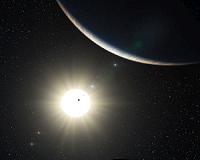 |
Science@NASA Huntsville AL (SPX) Aug 27, 2010 NASA's Kepler spacecraft has discovered the first confirmed planetary system with more than one planet crossing in front of, or transiting, the same star. The transit signatures of two distinct Saturn-sized planets were seen in the data for a sun-like star designated "Kepler-9." The planets were named Kepler-9b and 9c. The discovery incorporates seven months of observations of more than 156,000 stars as part of an ongoing search for Earth-sized planets outside our solar system. The findings will be published in Thursday's issue of the journal Science. Kepler's ultra-precise camera measures tiny decreases in the stars' brightness that occur when a planet transits them. The size of the planet can be derived from these temporary dips. The distance of the planet from the star can be calculated by measuring the time between successive dips as the planet orbits the star. Small variations in the regularity of these dips can be used to determine the masses of planets and detect other non-transiting planets in the system. In June, mission scientists submitted findings for peer review that identified more than 700 planet candidates in the first 43 days of Kepler data. The data included five additional candidate systems that appear to exhibit more than one transiting planet. The Kepler team recently identified a sixth target exhibiting multiple transits and accumulated enough follow-up data to confirm this multi-planet system. "Kepler's high quality data and round-the-clock coverage of transiting objects enable a whole host of unique measurements to be made of the parent stars and their planetary systems," said Doug Hudgins, the Kepler program scientist at NASA Headquarters in Washington DC. Scientists refined the estimates of the masses of the planets using observations from the W.M. Keck Observatory in Hawaii. The observations show Kepler-9b is the larger of the two planets, and both have masses similar to but less than Saturn. Kepler-9b lies closest to the star with an orbit of about 19 days, while Kepler-9c has an orbit of about 38 days. By observing several transits by each planet over the seven months of data, the time between successive transits could be analyzed. "This discovery is the first clear detection of significant changes in the intervals from one planetary transit to the next, what we call transit timing variations," said Matthew Holman, a Kepler mission scientist from the Harvard-Smithsonian Center for Astrophysics in Cambridge, Mass. "This is evidence of the gravitational interaction between the two planets as seen by the Kepler spacecraft." In addition to the two confirmed giant planets, Kepler scientists also have identified what appears to be a third, much smaller transit signature in the observations of Kepler-9. That signature is consistent with the transits of a super-Earth-sized planet about 1.5 times the radius of Earth in a scorching, near-sun 1.6 day-orbit. Additional observations are required to determine whether this signal is indeed a planet or an astronomical phenomenon that mimics the appearance of a transit.
Share This Article With Planet Earth
Related Links Kepler mission Lands Beyond Beyond - extra solar planets - news and science Life Beyond Earth
 Richest Planetary System Discovered
Richest Planetary System DiscoveredParis, France (SPX) Aug 26, 2010 Astronomers using ESO's world-leading HARPS instrument have discovered a planetary system containing at least five planets, orbiting the Sun-like star HD 10180. The researchers also have tantalising evidence that two other planets may be present, one of which would have the lowest mass ever found. This would make the system similar to our Solar System in terms of the number of planets (sev ... read more |
|
| The content herein, unless otherwise known to be public domain, are Copyright 1995-2010 - SpaceDaily. AFP and UPI Wire Stories are copyright Agence France-Presse and United Press International. ESA Portal Reports are copyright European Space Agency. All NASA sourced material is public domain. Additional copyrights may apply in whole or part to other bona fide parties. Advertising does not imply endorsement,agreement or approval of any opinions, statements or information provided by SpaceDaily on any Web page published or hosted by SpaceDaily. Privacy Statement |